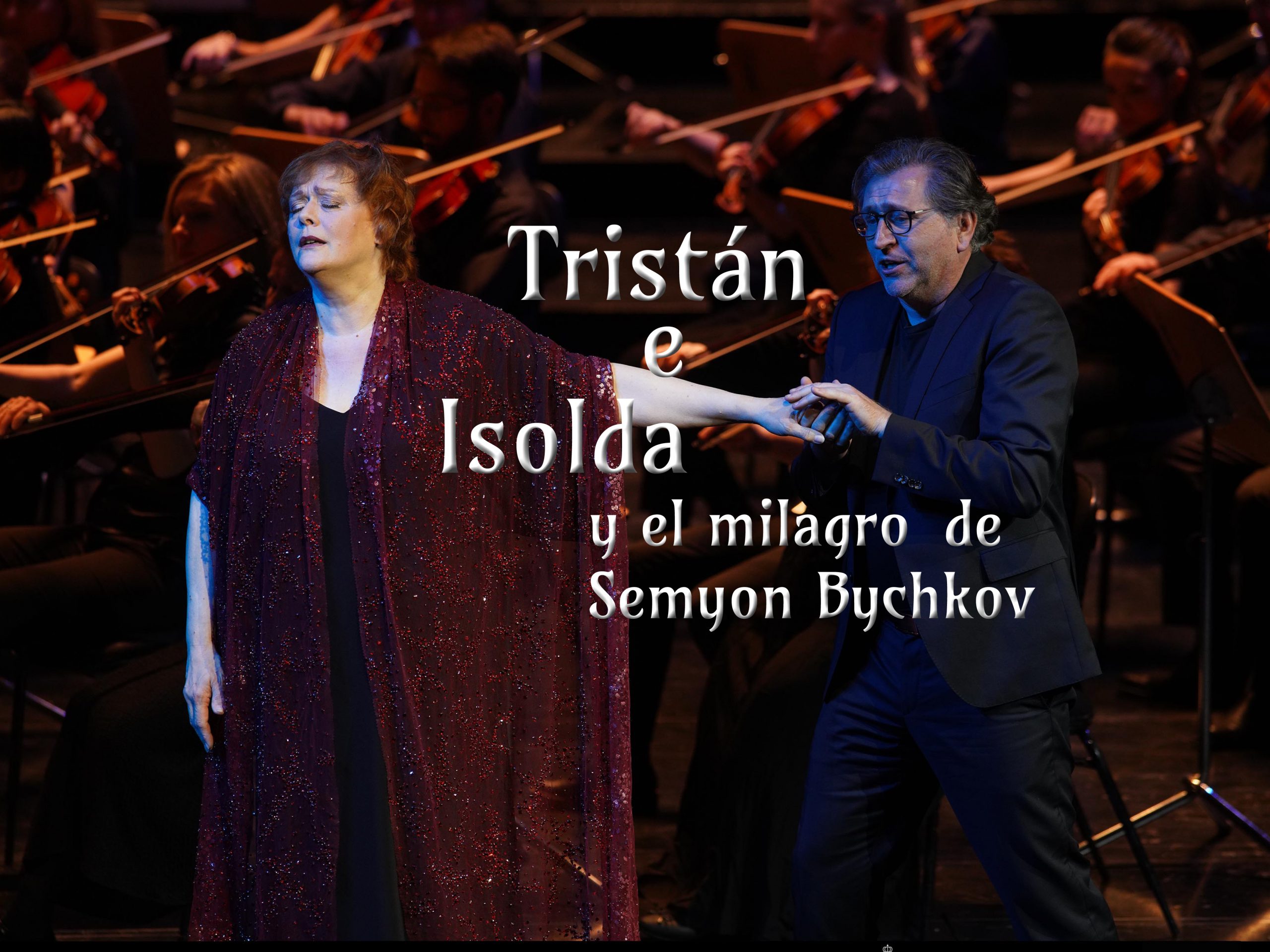
Tristán e Isolda de Richard Wagner (1813-1883)
Ópera en versión de concierto semiescenificada. Acción en tres actos
D. musical: Semyon Bychkov. D. coro: Andrés Máspero
Reparto: Catherine Foster, Andreas Schager, Franz-Josef Selig, Ekaterina Gubanova, Brian Mulligan, Neal Cooper, Jorge Rodríguez-Norton, Alejandro del Cerro y David Lagares.
Teatro Real de Madrid 6 de mayo de 2023.
No hay una temporada en el Teatro Real sin su Wagner, y esta vez le ha tocado el turno a Tristán e Isolda. Lo ha hecho en versión semiescenificada, en mi opinión, la mejor forma de ofrecer esta ópera. Los cantantes interactúan lo justo y nada distrae de lo verdaderamente importante, la música. No es una obra que requiera de grandes alardes escénicos, son pocos los personajes y onírico el ambiente que la envuelve, por lo que es un acierto esta manera de ofrecerla.
En una carta dirigía a Listzt en 1854, Wagner se expresaba de este modo: “Ya que no he conocido en vida la verdadera felicidad del amor, quiero levantar un monumento al más bello de los sueños, en el cual ha de satisfacerse, de principio a fin, ese amor”. Esta idea, fruto del tormentoso amor entre Wagner y Mathilde Wessendonck, influyó en distintas obras del compositor alemán, sobre todo en Tristán e Isolda.
La obra comienza con un acorde de tres notas en un registro grave y ascendente de los violonchelos al unísono. Un acorde que se desarrolla a lo largo de la obra y que solo se resuelve al final, con la muerte de Isolda (spoiler).
La muerte por amor resuelve la disonancia. Se crea así un tratamiento armónico único, nunca escuchado, que cambia desde ese momento los planteamientos de la estructura musical. Es el llamado ”acorde Tristán”, que impulsa siempre la música hacia adelante, en una envolvente infinita que apenas se relaja en un par de interludios. La riqueza armónica y el viaje inagotable que propone el compositor solo finaliza en el último momento.
Wagner catalogó Tristán como acción/trama, o Handlung. Esta obra no se basa en ningún acontecimiento histórico, sino en momentos y personajes mitológicos. Se pueden distinguir dos tramas o dos mundos distintos, el mundo real o racional, al que pertenecen los personajes de Brangäne, Kurwenal, Melot y el Rey Marke, y el mundo interior, el de los sueños y el amor en el que viven Tristán e Isolda. Es este mundo interior el que mejor describe Wagner en su partitura, situando siempre el plano de la realidad al final de cada acto. El resto de la obra pertenece a los sueños de sus protagonistas.
Y si el acorde principal de esta ópera es infinito, también lo son los movimientos pausados de su director musical Semyon Bychkov. El gesto siempre templado y seguro del director musical, atendía a cada una de las entradas de la orquesta y de los cantantes. Hizo que la orquesta sonara como pocas veces. Con un sonido limpio y transparente, con un cuidado equilibrio en los metales y las cuerdas. Ese gesto suave y envolvente, que parecía que le hacía avanzar en el mar de música sin dificultades, sin brusquedades ni aspavientos. Toda una lección de capacidad y conocimiento de la obra y de los tiempos.
Habituales de Festivales como Leipzig y Bayreuth, el cuadro de voces que se han reunido en el Real, han demostrado su calidad y conocimiento de canto wagneriano.
Para el rol de Isolda estaba anunciada Ingela Brimberg, que fue sustituida por Catherine Foster. No se como habría resultado Brimberg, pero la británica, que tiene una larga trayectoria wagneriana, ha sido una Isolda enorme. Tiene una voz lírica rebosante, un agudo pleno, lleno de metal y brillo. Su emisión es limpia, controlada, segura, sin asperezas. Supo dotar al personaje de la furia inicial para transformarlo en romanticismo e ingenuidad al final. Una brillante Isolda.
Tristán ha sido interpretado por el tenor alemán Andreas Schager, conocido y apreciado en este Teatro y otro wagneriano de pro. Se encuentra en un momento pletórico de voz, con ese metal en sus agudos y zona central. Sobre el escenario es incansable, lo da todo siempre. Venía de interpretar la tetralogía en Berlín pero su voz parece no necesitar descanso. Afronta toda la obra con la misma intensidad sin que su voz ni su fraseo se fatiguen.
El irlandés Brian Mulligan nos regaló un Kurwenal lleno de nobleza y fidelidad a Tristán. También en lo vocal se puso apreciar la nobleza, con su timbre limpio y agudo demostró esas cualidades, tanto en los momentos de exaltación heroica como en los más dramáticos.
La rusa Ekaterina Gubanova fue una espléndida Brangane. Siempre elegante, con abundante caudal, fraseo limpio y seguro y esas tonalidades oscuras que tanta personalidad aportan al personaje.
el bajo alemán Franz Josef Selig, también muy conocido por el público, volvió a interpreta el rol de rey Marke. Su presencia escénica, como la oscuridad y profundidad de du timbre, visten a la perfección el personaje. Escenicamente tuvo momentos de especial brillo, sobre todo en la emoción que supo trasmitir en la muerte de Tristán.
Neal Cooper estuvo acertado en su interpretación de Melot, un personaje astuto bien delineado por el tenor británico a través de su voz acerada.
La representación española estuvo a cargo de Alejandro del Cerro, Jorge Rodríguez Norton y David Lagares que estuvieron a una gran altura en medio de este impresionante reparto.
Un acierto esta programación de Tristán e Isolda, un regalo convertido en acontecimiento por el reparto y por un Semyon Bychkov que obró el milagro.
Texto: Paloma Sanz
Fotografía: Javier del Real/Teatro Real
